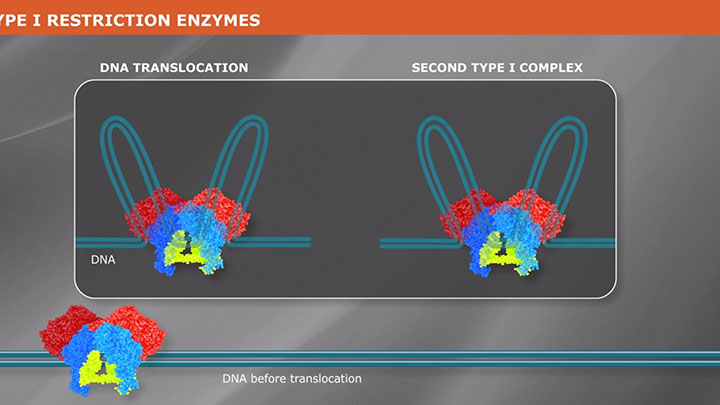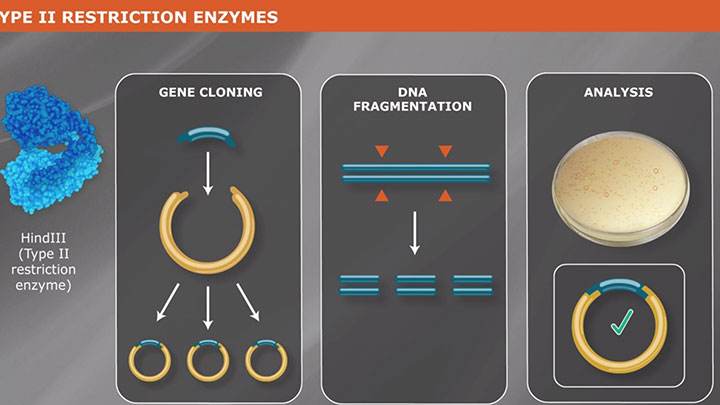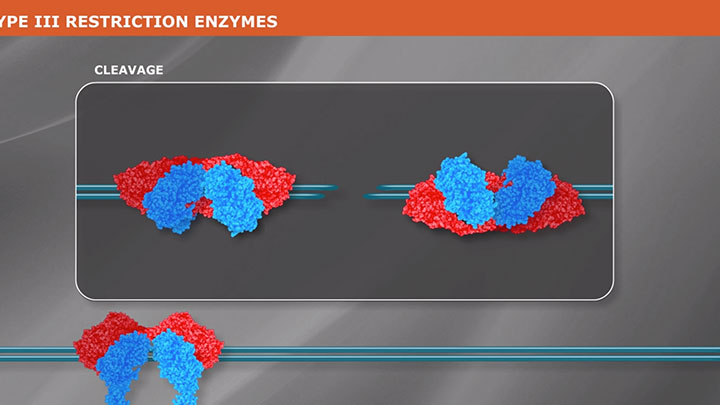What are Restriction Enzymes?

Script
Geoffrey Wilson PhD:
Well, restriction enzymes occur naturally in bacteria and bacteria use them themselves to break up DNA, foreign DNA, that infects bacterial cells. What we use them for is, we purify these enzymes from the bacteria and we use them to do the same sort of thing but in the test tube.
Natural DNA molecules are extremely long and extremely complicated. They're like a cassette tape which goes on for a very, very long distance the DNA itself is very thin molecule containing, along its length, genes. In order to analyze DNA and to isolate individual genes, we need to break it up and this is what restriction enzymes are used for. They're used to cut DNA up into convenient size pieces that we can then use to sub clone and to put it into bacteria and to study.
In the absence of DNA, they have a kind of open structure, like an open hand, or a pair of open hands, and when they encounter the DNA, they tend to wrap around it and then they can slide up and down the DNA for a certain distance without detaching. Restriction enzymes are also used as a quick way to identify DNA molecules, to characterize them because a restriction enzyme will recognize a particular sequence within a DNA molecule, and each time the sequence occurs, the molecule gets cut, so any particular DNA molecule will get cut into a series of fragments, the sizes and number of which are characteristic of that particular DNA molecule that you're dealing with. The result is that you can use an enzyme, if you want to check a DNA molecule you're dealing with, you can use a restriction enzyme to do a quick digest, and you can electrophorese the digested DNA on a agarose gel and produce a restriction fragment, the characteristic restriction fragment pattern.
In the early days of molecular biology, when restriction enzymes came along, it suddenly became possible to take bits of DNA from any organism and put these into a vector, and put them into E.coli, and study that particular DNA. And this was a new form of genetics. And it was clear to me that this was going to be extremely important, not only for the study of molecular biology but also for the study of medicine. But what would be necessary would be, to move this field forward, we would need not only a lot of restriction enzymes, but we'd need pure restriction enzymes, and we'd need to be able to make them in quantity. So I got involved with restriction enzyme research at the level of trying to over express their genes, trying to clone their genes from the bacteria that made them naturally and put them into E coli, get them over expressed, make little E. Coli factories that made a lot of these proteins.
The object was in those days, to improve the tools that scientists would have at their disposal. I tell you, that the way the sort of developed was each restriction enzyme recognizes a particular sequence of bases on DNA and it cuts the DNA at those positions, but it ignores everything else. And a typical restriction enzyme might recognize a six based sequence. Now there are over 4,000 different six based sequences in DNA, a restriction enzyme will recognize one of the sequences, but ignore all 3,999 others. Some restriction enzymes recognize eight based sequences, and there are 64,000 possible eight based sequences so these enzymes will ignore 63,999 different DNA sequences, but bind to just one.
Now this is extraordinary selectivity, and we want to know how it occurs. I mean, for sure it's a natural process, it's going on in bacteria, this sort of selectivity is probably going on in other organisms including ourselves, we want to know the molecular basis for it.
Related Videos
-

What is a Type I Restriction Enzyme? -

What is a Type II Restriction Enzyme? -

What is a Type III Restriction Enzyme?

